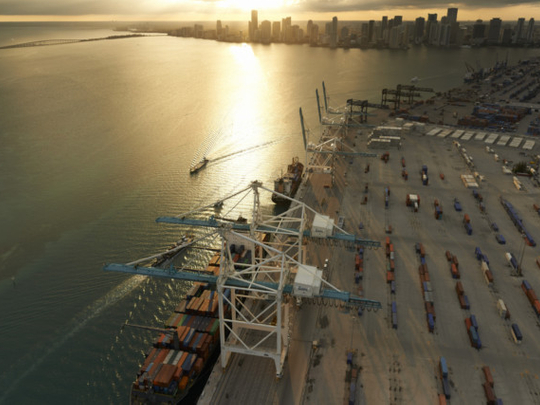
The US shipbuilding and maritime industry — mostly military shipbuilding and maintenance — has been in a slump not only since the financial crisis of 2008, it has suffered a steady decline for more than three decades along with the vanishing US maritime position in international trade.
The industry’s most important customers, the government and military, have been ordering fewer ships. And during the economic crisis, Congress imposed deep spending cuts on the sector that is mainly reliant on public funds.
However, the shipbuilding business seems too big to fail. It still has a considerable market share in domestic river transport, and the shipyards play an important role in maintaining navy vessels and a few commercial seagoing ships.
Struggling with transition
Inland waterborne transportation still plays a key role in moving grain, coal and other bulk commodities from the nation’s interior states down the Mississippi River to Louisiana, where they are sent around the world. However, waterways suffer from decaying dams and locks and are in urgent need of upgrading.
The US shipbuilding industry is also struggling with a transition from defence to commercial markets. Decades ago, the entire industry was a highly subsidised quasi-monopoly that almost entirely delivered vessels to the US navy, especially after the Reagan administration stopped subsidies for commercial shipbuilding in 1981, causing the commercial market to collapse and making it even more dependent on the government.
The industry was able to stay afloat between 2006 and 2010, when many navy ships had to be renewed due to their age, but the future looks somewhat bleak for shipbuilders.
The report Economic Importance of the US Shipbuilding and Repairing Industry was released by the US Maritime Administration in June 2012. It showed that the nation’s shipyards account for $36 billion (about Dh95 billion) of the country’s GDP. In 2011, the nation’s more than 300 shipyards directly provided more than 107,000 jobs and $7.9 billion in labour income to the national economy. Currently, the US merchant marine comprises about 460 vessels. Some 700 ships owned by US firms that are registered or flagged in other countries are not included in this number.
The average income for maritime industry jobs, $73,000 per year, is 45 per cent higher than the national average. On a nationwide basis, including direct, indirect and induced impact, the industry supports 402,010 jobs and $23.9 billion of labour income, the study revealed.
The report considered the economic impact of the private shipbuilding and repair sector as a whole, including shipyards and industry suppliers. It also looked at multiplier effects such as revenue at small businesses serving maritime workers and their families.
Economic impact
“The economic impact of shipbuilding and repair extends beyond our coasts, the Great Lakes and inland waterways,” says Frank Foti, Chairman of the Shipbuilders Council of America.
“Shipyard work supports good paying jobs for skilled industrial craftspeople in all 50 states.”
The US shipping industry is still based on the Merchant Marine Act of 1920, better known as the Jones Act, which deals with all maritime issues. Its main purpose is to support the sector by not allowing foreign shipping companies to enter the US market. But the act has also been criticised as being too protective, forcing the US shipping industry to move cargo and build ships at far higher costs than elsewhere.
Currently, the US builds less than 1 per cent of the world’s commercial fleet, and there is no US-flagged international shipping fleet to speak of. While maritime industry officials praise its high wage level, the industry would never be able to compete internationally with vessels built and registered in other nations with crews willing to work for wages that are a fraction of what their US counterparts earn.
“If the government protection of the industry and the waste of tax money on a totally inflexible business model continues, this would eventually lead to the remaining US shipyards being deconstructed or outsourced overseas, resulting in the utter destruction of the US maritime industry,” said Senator John McCain when he introduced the Open Water Act 2010. The bill aimed at repealing the Jones Act and opening the industry to foreign vessel operators in order to save consumers and taxpayers billions per year.
“In turn, this would result in higher costs for US navy vessels and eventually require most naval ships meant for national defence to be built overseas as well,” he added.
However, the bill failed and the uncompetitive situation persists.
Money matters
Many US-owned carriers now lack the capital needed to build the enormous modern tankers and container ships that haul cargo around the world, let alone the revenues to run them, and thus they are unable to compete with foreign carriers, who often have lower operating costs. This has led to a paradox.
Military cargo, for example, for the US army’s involvement in the Iraq and Afghanistan conflicts had to be delivered on US-flagged but foreign-owned cargo ships. Maersk, a Danish shipping company, transported almost half of the weapons, humvees, tanks, fuel and ammunition to the war zones, an operation that cost US taxpayers $2 billion.
The US navy has a presence in the UAE with the Fifth Fleet stationed at Jebel Ali. 7







